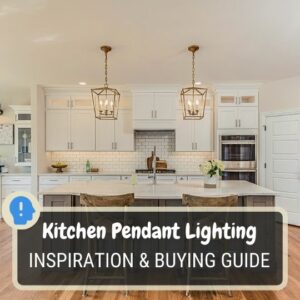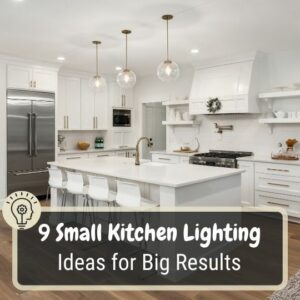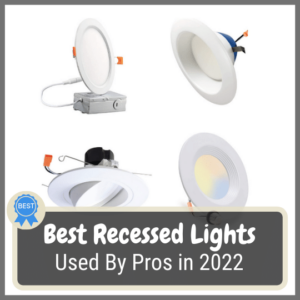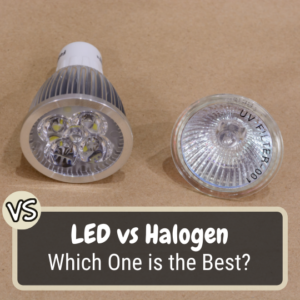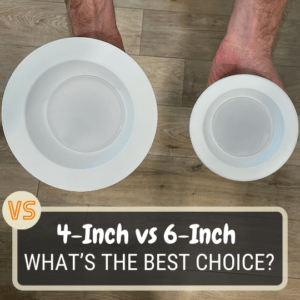
Recessed lighting is an ideal solution to provide lighting in rooms with sloped ceilings. It allows you to maintain the open feeling that a room with a vaulted ceiling has, and doesn’t interfere with the architectural lines. While the installation can be more difficult than it would be in a flat ceiling, the special considerations outlined in this post will ensure your lighting turns out great.
Types of LED Recessed Lights for Sloped Ceilings
Adjustable Recessed Light Fixtures

Adjustable LED recessed lights (aka Gimbal, Eyeball or Directional lights) have an axis that allows them to be aimed downward rather than following the ceiling pitch. There are several variations of adjustable lights, with the biggest difference between them being their range of motion.
Angle-cut Recessed Light Fixtures

Angle-cut fixtures (aka Sloped Ceiling Recessed Lights) are specifically designed for use with sloped ceilings. The trim aperture is cut at an angle to coincide with the slope of the ceiling, while the LED light bulb or lens points straight down towards the floor below.
Between the two types, you’ll find more options for Adjustable LED fixtures and they will typically cost less than Angle-Cut fixtures.
Why Not Use Fixed (non-adjustable) Recessed Lights?
The reason not to use standard recessed lights on a vaulted ceiling is glare. If you use a fixed recessed light on a slope, the light will be aimed at the same angle as the ceiling. This may not seem like a big deal, but when you are in the room it can feel like the sun is shining in your eyes. When you use an adjustable or angle-cut fixture, the result is significantly less glare because the beam of light shines down towards the floor rather than towards your eyes.
Exceptions to the Rule
There are some circumstances where using standard (non-adjustable) recessed lights in a sloped ceiling will have a minimal negative impact. If the pitch of the ceiling is low, then standard lights will be fine.
A small room like a bedroom that has a tall sloped ceiling is another instance where using fixed lights will have very little impact on glare. This is because when you are in the room the lights are well above your line of sight.
What Size Recessed Lights for a Sloped Ceiling?
When deciding between using 4 inch or 6 inch LED lights, there are two common approaches to the design.
The first approach is based on the scale of the room. With this approach, you’d use large diameter lights (6-inch) if the room is considered large, and small diameter lights (4-inch) if the room is small.
The second approach is to use small lights regardless of the size of the room, because the smaller lights are less noticeable and blend better with the ceiling.
Recessed Lighting Placement for Sloped Ceilings
General Ambient Lighting
As with flat ceilings, the lighting layout on a vaulted ceiling should be an even pattern to distribute the light. I recommend using the dimensions of the room to calculate the number of lights needed, and the dimensions of the ceiling to calculate the placement on the ceiling. This is because the length of the ceiling will be longer due to the slope.
Task Lighting
Effective task lighting is achieved when the light source is positioned between you and a surface. This is difficult to do from a cathedral ceiling due to the ceiling height. For this reason, task lighting is not ideal from tall ceilings, especially when they’re angled.
Accent Lighting
Accent lighting is possible from a sloped ceiling if the subject is directly below, but highlighting artwork hanging on the wall can be difficult. Most recessed fixtures will not have enough adjustment range to compensate for the pitch of the ceiling.
Installation Challenges
Installing recessed lights in a vaulted ceiling can be considerably more difficult than a flat ceiling. Before you hire an electrician or contractor, make they’re experienced and familiar with this type of lighting installation. Let’s look at the biggest challenges an installer will face.
Working Height
Vaulted ceilings can be much taller than flat ceilings, so they’ll require the use of tall ladders or scaffolding to safely reach and perform the installation. Working overhead while standing on a tall ladder is not easy.
Limited Attic Access
Many vaulted ceilings are constructed with the roof directly on top of the ceiling joists, which means there is no access from above. This makes running new wiring to the lights very difficult. It’s likely that some access holes will need to be cut in the ceiling and wall to run the wiring between the lights and the wall switch.
Insulation
Almost all ceilings have insulation directly above which can make it difficult to fish new wiring.
Clearance Issues
Some sloped ceilings only have a few inches of depth between the ceiling and the roof. When this is the case, the use of shallow recessed housings may be the only option.
Wood Ceilings
Some sloped ceilings are finished with tongue and groove wood boards. The wood could be the actual ceiling itself, or the boards could be a decorative feature installed over a drywall or plaster ceiling.
From an installation standpoint, this is probably the most challenging type of installation because access holes cannot be made to run the wiring. Be sure whoever you hire is very experienced installing recessed lighting in this type of ceiling.
Potential Drawbacks to Recessed Lighting in a Vaulted Ceiling
Glare
As I previously mentioned, it’s important to use recessed light fixtures that can be aimed down rather than towards the occupants of the room. Otherwise, the lights will produce uncomfortable glare that outweighs the benefit of having overhead lighting in the first place.
Brightness/Effectiveness
The LED downlights used in tall ceilings should have a minimum brightness of 600 lumens. In my opinion, the higher output the better. The brightness can easily be controlled using a dimmer switch.
Difficulty to Replace
Replacing a recessed light in a tall ceiling can be difficult, and sometimes requires special equipment such as tall ladders or scaffolding to safely reach. Fortunately, if you use high quality LED recessed lights they will typically last 20+ years before needing to be replaced.
Conclusion
LED recessed lights can be the perfect solution for lighting rooms with sloped ceilings. Homeowners can ensure the best possible outcome by using the proper type of lights and having them installed by an experienced professional.

